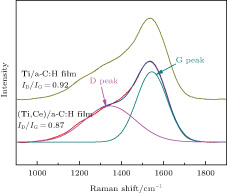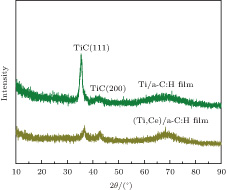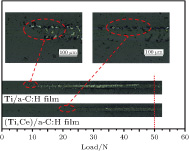† Corresponding author. E-mail:
WC cemented carbide suffers severe wear in water environments. A novel carbon-based film could be a feasible way to overcome this drawback. In this study, a rare earth Ce-modified (Ti,Ce)/a-C:H carbon-based film is successfully prepared on WC cemented carbide using a DC reactive magnetron sputtering process. The microstructure, mechanical properties, and tribological behavior of the as-prepared carbon-based film are systematically investigated. The results show that the doping Ti forms TiC nanocrystallites that are uniformly dispersed in the amorphous carbon matrix, whereas the doping Ce forms CeO2 that exists with the amorphous phase in the co-doped (Ti,Ce)/a-C:H carbon-based film. The mechanical properties of this (Ti,Ce)/a-C:H film exhibit remarkable improvements, which could suggest higher hardness and elastic modulus as well as better adhesive strength compared to solitary Ti-doped Ti/a-C:H film. In particular, the as-prepared (Ti,Ce)/a-C:H film presents a relatively low friction coefficient and wear rate in both ambient air and deionized water, indicating that (Ti,Ce)/a-C:H film could feasibly improve the tribological performance of WC cemented carbide in a water environment.
WC cemented carbide offers high strength, high hardness, high temperature resistance, oxidation resistance, and chemical corrosion resistance, and is widely used in petroleum drilling, mechanical seals, underwater strand pelletizing systems, underwater axle bearings, and so on. [1–4] Unfortunately, when WC cemented carbide is used in water environments, it exhibits poor tribological performance because of the low viscosity of water. In particular, it offers less lubrication, causing the friction coefficient to rise sharply and resulting in very serious wear under conditions in which the friction pair suffers instantaneous overload or frequent start–stop phases. [5, 6] Therefore, enhancing the surface of WC cemented carbide so as to eliminate these problems in water environments is of significant importance. Diamond-like carbon (DLC) films possess high hardness, low friction, and high wear resistance. Thus, they have widespread applications in many industrial fields, and could exhibit good tribological performance in water environments. [7–13] As a result, it should be feasible to deposit DLC films on WC cemented carbide to achieve better tribological performance.
The relatively high internal stress and low toughness of DLC could cause low adhesion and even peeling of the films from substrates. It has been reported that a metallic Ti transition layer enhances the adhesion strength to the substrate; metallic Ti doping could also reduce internal stress significantly while maintaining the hardness, friction coefficient, and wear of DLC films. [13–15] In particular, it was reported that co-doping in DLC films could improve their tribological performance, e.g., aluminum/titanium, aluminum/chromium, copper/titanium co-doped DLC films. [16–18] DLC doping with rare earth elements is an important direction of research in surface engineering. The resulting DLC films could exhibit good internal stress, friction coefficient, and wear rate properties. [19, 20] When a rare earth element was used to dope DLC film, the internal stress decreased by approximately 70% and the friction coefficient went from 0.1 to 0.09. [20] Moreover, the doped rare earth element was dissolved within the DLC amorphous matrix, but did not form nanoparticles. [21, 22] Although duplex-doped DLC film with rare earth elements has been reported, this combined a single rare earth element with another element, such as cerium and lanthanum. [19, 23] There are few reports of rare earth elements accompanied by metallic titanium to prepare duplex-doped nanocomposite carbon-based film. Additionally, this rare earth modified carbon-based film does not appear to have been used as a strategy to improve WC cemented carbide.
In this paper, we report the use of Ce-modified nc-TiC/a-C:H carbon-based film to prepare (Ti,Ce)/a-C:H composite carbon-based film on a WC cemented carbide substrate using a DC reactive magnetron sputtering process. The morphologies, microstructure, and mechanical properties of the as-prepared (Ti,Ce)/a-C:H carbon-based film are systematically characterized, and the friction and wear behavior are evaluated in both ambient air and deionized water conditions.
The hydrogenated (Ti,Ce)/a-C:H carbon-based film was deposited on mirror-polished Si p(100) wafers and WC cemented carbide (Co% = 8 at.%) substrates (with dimensions of 30 mm ×30 mm ×2 mm) by DC reactive magnetron sputtering using CH4 as the carbon source gas. To compare with (Ti,Ce)/a-C:H film, a solitary Ti-doped Ti/a-C:H was prepared simultaneously. It has been reported that the Co phase could induce interfacial graphitization and decrease the adhesion strength; [24] thus, pretreated WC cemented carbide using potassium hydroxide solution and Caro’s acid were used to eliminate the Co phase from the WC cemented carbide substrate surface. Prior to deposition, the WC cemented carbide substrates were ultrasonically cleaned in acetone for 20 min, ethanol for 20 min, deionized water for 10 min, potassium hydroxide solution (10 g KOH + 100 ml H2O) for 30 min, Caro's acid (30 ml H2SO4:70 ml H2O 


| Table 1.
Deposition parameter of as-prepared carbon-based films. . |
The as-prepared film thicknesses were measured by field emission scanning electron microscope (FESEM) (Hitachi S4800) via observation of their cross-sectional surface. The surface roughness and morphology were measured by atomic force microscopy (AFM) (CSPM5000). The chemical bonding states and composition of the as-prepared carbon-based films were confirmed by x-ray photoelectron spectroscopy (XPS) (Kratos AXIS ULTRA). The phases of the as-prepared films were characterized by x-ray diffraction (XRD) (Bruker D8 x-ray facility). The adhesion strength and hardness of the as-prepared films were evaluated using a Revetest CSM scratch tester and MTS Nano-Indenter G200 system. The tribological behavior of the Ti/a-C:H and (Ti,Ce)/a-C:H films in ambient air and deionized water conditions at room temperature were evaluated on the HSR-2M reciprocating sliding tribometer. As the counter body, the diameter of the WC cemented carbide ball was 5 mm, and all frictional tests were carried out under a load of 5 N, reciprocating frequency of 5 Hz, and an amplitude of 5 mm. Subsequently, the morphologies of the wear tracks and wear scars were characterized using a scanning electron microscope (SEM) (TM3030). The wear rates obtained after the sliding tests were completed based on the wear track depth profiles detected by a NanoMap 500LS profilometer.
The surface morphologies of the as-prepared Ti/a-C:H and (Ti,Ce)/a-C:H carbon-based films were characterized by AFM, as shown in Figs.
 | Fig. 1. (color online) The two- and three-dimensional AFM surface morphologies of (a) Ti/a-C:H film and (b) (Ti,Ce)/a-C:H film. |
Cross-sections of the as-prepared Ti/a-C:H and (Ti,Ce)/a-C:H carbon-based films were characterized via FESEM, as shown in Fig. 

 | Fig. 2. (color online) Cross-sectional images of as-fabricated films: (a) Ti/a-C:H film and (b) (Ti,Ce)/a-C:H film. |
The chemical composition of the as-prepared carbon-based films was measured by XPS at approximately 92.76 at.% C and 1.25 at.% for the Ti/a-C:H film and approximately 93.47 at.% C, 0.96 at.% Ti and 0.28 at.% Ce for the (Ti,Ce)/a-C:H carbon-based film (see Table 



 | Fig. 3. (color online) XPS (a) Ce 3d spectra of (Ti,Ce)/a-C:H film and (b) C 1s spectra of Ti/a-C:H and (Ti,Ce)/a-C:H films. |
| Table 2.
Chemical composition and mechanical properties of Ti/a-C:H and (Ti,Ce)/a-C:H films. . |
DLC film is often characterized by Raman spectroscopy. Generally, the Raman spectra of DLC film exhibit an asymmetric broad peak in the range 900–1900 cm 







Figure
Furthermore, HRTEM was conducted to identify the nanocrystalline and amorphous structures of the as-prepared carbon-based films, as shown in Fig. 
The scratch and nanoindentation technique was used to characterize the mechanical properties of the as-prepared films, and the critical load (


The adhesive strength of the Ti/a-C:H and (Ti,Ce)/a-C:H films was evaluated by scratch tests, and the optical microscope images of the scratch tracks are shown in Fig.
Friction tests in ambient air were conducted on the Ti/a-C:H and (Ti,Ce)/a-C:H films. The friction coefficients as a function of sliding time are shown in Fig. 

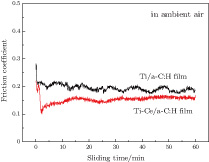 | Fig. 8. (color online) Friction coefficient versus sliding time for Ti/a-C:H film and (Ti,Ce)/a-C:H film in ambient air. |
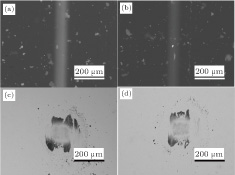 | Fig. 9. (color online) SEM images of wear tracks and wear scars on the counterfaces in ambient air for Ti/a-C:H film ((a), (c)) and for (Ti,Ce)/a-C:H film ((b), (d)). |
Investigations into the tribological behavior of DLC film confirm that graphitization at the contact area of the ball and the film is the primary reason for low friction. [28, 29] The SEM images of the wear scars clearly show a graphitic transferred layer. Moreover, the lower friction coefficient of the (Ti,Ce)/a-C:H film could be a result of the Ce co-doping. It is thought that CeO2 could accelerate physicochemical reactions at the friction surface and enrich C, O elements in the contact area. [30] Thus, the properties of CeO2 may favor the formation of a graphitic transferred layer, giving the (Ti,Ce)/a-C:H film a lower friction coefficient. However, the H/E ratio is regarded as the primary material property of DLC film in terms of wear resistance, [31] and the H/E ratios of the Ti/a-C:H film and (Ti,Ce)/a-C:H film are the same. This indicates that the relative content of sp3-C and hardness might play an important role in the process of friction tests. It has been reported that high hardness prevents wear because of the high carrying capacity under the action of high-speed friction testing. [32, 33] From the above XPS, Raman, and mechanical properties analyses, the (Ti,Ce)/a-C:H film possesses a higher relative content of sp3-C (sp3/(sp2+sp 

The tribological properties of the as-prepared carbon based films were also characterized under deionized water conditions and the friction curves are shown in Fig. 

 | Fig. 10. (color online) Friction coefficient versus sliding time for Ti/a-C:H film and (Ti,Ce)/a-C:H film in deionized water. |
 | Fig. 11. (color online) SEM images of wear tracks and wear scars on the counterfaces in deionized water for Ti/a-C:H film ((a), (c)) and for (Ti,Ce)/a-C:H film ((b), (d)). |
The friction and wear of the as-prepared carbon based films are different under ambient air and deionized water conditions. Obviously, the friction coefficient and wear rate in ambient air are higher than in deionized water—the friction coefficients went from 0.19 and 0.15 in air to 0.10 and 0.05 in water, and the wear rates decreased from 



A rare earth Ce-modified (Ti,Ce)/a-C:H carbon-based film was successfully deposited on WC cemented carbide using a DC reactive magnetron sputtering process. The morphologies, microstructure, and mechanical properties of the as-prepared film were characterized systematically, and the friction and wear behavior were evaluated in both ambient air and deionized water conditions. Our findings can be summarized as follows: The doping Ti forms TiC nanocrystallites and uniformly disperses in the amorphous carbon matrix, whereas the doping Ce forms CeO2 that exists with the amorphous phase in the co-doped (Ti,Ce)/a-C:H carbon-based film. The co-doped (Ti,Ce)/a-C:H carbon-based film exhibits better friction and wear properties compared with the solitary Ti-doped Ti/a-C:H film, achieving a relatively low friction coefficient of 0.15 and wear rate of The most striking performance was observed in deionized water: the (Ti,Ce)/a-C:H carbon-based film exhibits a lower friction coefficient (0.05) than the Ti/a-C:H film (0.10) and a lower wear rate of


| [1] | |
| [2] | |
| [3] | |
| [4] | |
| [5] | |
| [6] | |
| [7] | |
| [8] | |
| [9] | |
| [10] | |
| [11] | |
| [12] | |
| [13] | |
| [14] | |
| [15] | |
| [16] | |
| [17] | |
| [18] | |
| [19] | |
| [20] | |
| [21] | |
| [22] | |
| [23] | |
| [24] | |
| [25] | |
| [26] | |
| [27] | |
| [28] | |
| [29] | |
| [30] | |
| [31] | |
| [32] | |
| [33] | |
| [34] | |
| [35] |


